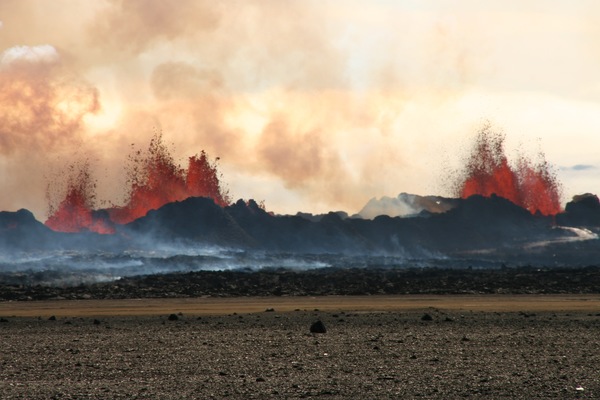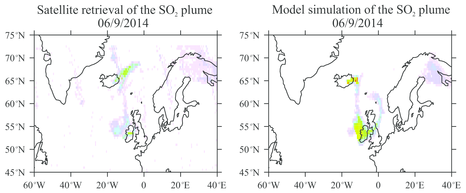This is a guest post by Anja Schmidt, an Academic Research Fellow at Leeds University, and Claire Witham of the Met Office’s Atmospheric Dispersion Group. It describes Anja’s paper quantifying the sulphur dioxide gas release from the 2014 eruption of Iceland’s Bárðarbunga volcanic system at Holuhraun that she wrote with Claire and a large, international, team of scientists, including myself.
The biggest Icelandic eruption in more than 200 years
It is very likely that you remember the 2010 eruption of Eyjafjallajökull in Iceland and the ensuing travel chaos that resulted from volcanic ash drifting in and out of European and North Atlantic airspace for more than a month. In total 10 million travellers were stranded and the airline industry incurred financial losses in excess of 1.7 billion US dollars. Then, in 2011, another Icelandic volcano called Grímsvötn had an eruption about 100 times as powerful as Eyjafjallajökull, producing twice the amount of volcanic ash. Yet far fewer people will remember it due to its limited impact on aviation.
Ash-producing Icelandic eruptions affect Europe frequently – about once every three to five years. However, there are other types of volcanic eruptions in Iceland that typically produce very little volcanic ash but lots of lava and toxic volcanic gases. We generally refer to these as effusive eruptions and specifically as fissure eruptions. The biggest of these fissure eruptions produce lava volumes that fill up to 100,000 Olympic-sized swimming pools per day for months to years. These big eruptions occur on average every 200 to 500 years, whereas smaller-volume fissure eruptions occur every 40-50 years on average. In the early hours of 31 August 2014, the biggest fissure eruption in more than 200 years began about 45 km away from the Bárðarbunga volcano at the Holuhraun lava field (shown in Figure 1). This eruption was truly spectacular, lasting six months and presenting some great scientific opportunities. Yet not many people outside Iceland would have taken note because there was no disruption to air travel.

Figure 1. The top panel shows the locations of Icelandic towns and volcanoes, including the Bárðarbunga volcanic system. The red rectangle outlines the region shown in the bottom panel. The map in the bottom panel shows the Bárðarbunga caldera (dashed grey line) and the lava flow field and vents of the 2014-15 eruption at Holuhraun. Figure from Schmidt et al., (2015). Click image to enlarge.
No volcanic ash, but lots of lava and sulfur dioxide
During its first month, the eruption at Holuhraun was extremely powerful spewing fountains of lava up to 150 meters high (see Figure 2) along a 1.5 km long crack in the earth’s crust (which puts the “fissure” in “fissure eruption”). The eruption discharged lava at a rate of more than 200 m3/s, which is equivalent to filling five Olympic-sized swimming pools with lava each minute. Six months later, when the eruption ended, it had produced about 1.5 km3 of lava, covering an area of around 86 km2, which is the same area as Manhattan. In stark contrast to the eruptions of Eyjafjallajökull 2010 and Grímsvötn 2011, the eruption at Holuhraun produced negligible amounts of volcanic ash, but a lot of lava and sulfur dioxide. Sulfur dioxide is a toxic gas that was emitted into the lowermost atmosphere up to 6 kilometers high.

Figure 2. Lava fountaining above the volcanic fissure at Holuhraun (Iceland) in September 2014. Photo taken by Michelle Parks (University of Iceland). Click image to enlarge.
It became clear very quickly that the eruption was producing truly staggering amounts of sulfur dioxide, but continuous ground-based monitoring and measurement of the gas fluxes was very challenging due to the remoteness of the eruption site and the weather conditions in Iceland. This is where satellite data of the volcanic sulfur dioxide plume came to the rescue. In our new study we analysed such satellite data and combined these with computer modeling using the Met Office’s NAME model. This allowed us to track and compare the dispersion of volcanic sulfur dioxide (see Figure 3). It also enabled us to assess how much sulfur dioxide was emitted independent of the ground-based measurements in Iceland. We found that at its most powerful the eruption emitted about 120 kilotons of sulfur dioxide per day, which is eight times more than the daily amount of sulfur dioxide emitted from all man-made sources in Europe. We also calculated that during September 2014 a total of 2.0±0.6 million tons of sulfur dioxide was emitted by the eruption. This makes Holuhraun the largest volcanic sulfur pollution event in more than 200 years in Iceland. Its bigger sister, the Laki eruption took place in 1783-1784 CE and produced, over the course of 8 months, about ten times more lava and about 60 times more sulfur dioxide than Holuhraun did in September 2014. The Laki eruption is thought to have caused cooling of climate and substantial environmental stress across Europe in the mid-1780s.

Figure 3. The panel on the left shows the distribution of sulfur dixoide from the 2014-2015 eruption at Holuhraun on 6 September 2014 as seen by the satellite instrument called OMI which is onboard NASA’s Aura spacecraft. The panel on the right shows the distribution of sulfur dioxide as predicted by the computer model simulation for the same day. Figure from Schmidt et al., (2015). Click image to enlarge.
Detection and monitoring of volcanic sulfur pollution
Over the course of the eruption, air quality monitoring stations in Iceland recorded unprecedented levels of sulfur dioxide, often significantly exceeding the current 10-minute mean air quality standard for sulfur dioxide set by the World Health Organization (WHO) to protect public health. However, volcanic pollution was not confined to Iceland: our study shows that volcanic sulfur dioxide was transported over large distances and detected by air quality monitoring stations up to 2750 km away from Iceland. For instance, on 6 September 2014 volcanic pollution reached Ireland where air quality monitoring stations recorded short-lived (up to 24 hours) spikes in surface sulfur dioxide concentrations. Air pollution regulations introduced in the 1980s mean that sulfur dioxide levels due to emissions from industrial sources are very low nowadays; hence the concentrations recorded on 6 September 2014 were really unusual. Other stations across Northern and Central Europe recorded similar pollution episodes during September 2014.
The air quality monitoring stations across Europe were essential for the detection and characterization of the air pollution events resulting from the eruption. These observations and our model simulations demonstrate that volcanic pollution from Icelandic fissure eruptions can easily reach Northern Europe and degrade air quality temporally. Away from Iceland there was no risk of long-term detrimental health effects because exposure to volcanic pollutants was brief. Right now the number of sulfur dioxide monitoring stations across Europe is in steady decline because sulfur dioxide concentrations are usually very low as a result of successfully legislated reductions of man-made emissions since the 1980s. We argue that existing air quality monitoring stations ought to be retained or extended to monitor volcanic pollutants from future eruptions in Iceland. This would facilitate the characterization and mitigation of volcanic gas and aerosol particle hazards, which could be severe in the event of a large-magnitude Icelandic eruption like a repeat of the 1783-1784 CE Laki eruption in Iceland. The Scottish Environment Protection Agency is going to extend their air quality monitoring of sulfur dioxide and volcanic ash in response to the eruptions in Iceland since 2010.
The next eruption…
Every eruption is different and what the eruptions of Holuhraun and Eyjafjallajökull have shown is that future Icelandic eruptions will pose new hazards and challenges for science and society. With each eruption we learn more about the volcanic processes involved and broaden our understanding of how to best utilize observations and computer models to understand these hazards and inform decision makers. We cannot predict the next eruption, but recent activity proves that in Europe we should prepare for the impacts of not only volcanic ash but also volcanic gases and airborne particles.
Further reading
Our paper describing the results is open access, which means that anyone can download and read it for free. The full reference is:
- Schmidt A, Leadbetter S, Theys N, et al (2015) Satellite detection, long-range transport and air quality impacts of volcanic sulfur dioxide from the 2014–15 flood lava eruption at Bárðarbunga (Iceland). J Geophys Res Atmos 2015JD023638. doi: 10.1002/2015JD023638
I wrote a pair of blog posts describing fieldwork at the lava flow itself. You can can read them at:
There is also some background about even larger lava eruptions than at Bárðarbunga, including Laki 1783-84, in this post:
UPDATE: I was on the BBC Radio Scotland Drivetime show discussing the results of the study. You can listen to the interview below:

